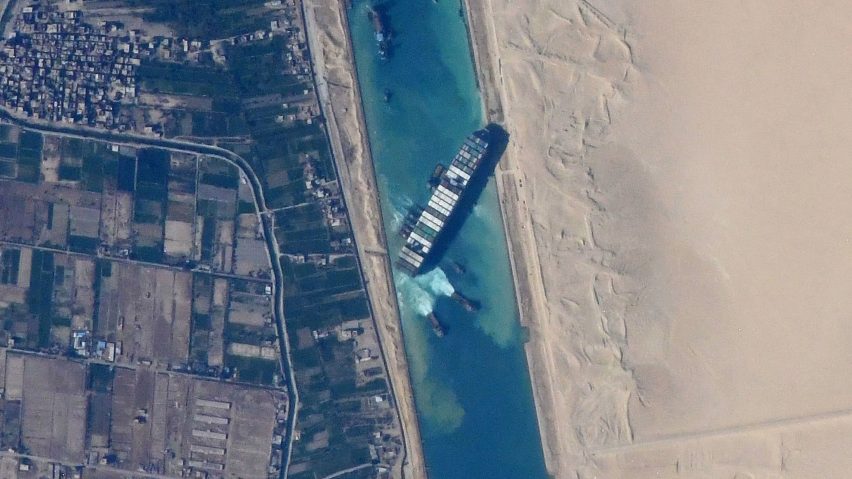The time when architecture and design involved creating new buildings and products is over, argues Beatrice Galilee in a manifesto written for the Dezeen 15 digital festival. Instead, the discipline must expand to include the systems and people it has long overlooked.
"The radical architecture of the future may come from architects who refuse to build at all," writes Galilee in her manifesto titled The Design We Can't See.
"The time when designers had the luxury of focusing only on end products has come to a close," she writes.
Dezeen 15 is a digital festival celebrating Dezeen's 15th birthday. Running from 1 to 19 November, it will feature a different manifesto for the future each weekday. See the line-up here.
The Design We Can't See
The image of the world's largest container ship, the Ever Given, gracelessly splayed sideways across the Suez Canal, blocking 12 per cent of the planet's cargo, while a pair of guys in hi-vis vests stand on the banks beside it with their hands on their hips, made for some solid memes for a week or so.
It also became an instant metaphor for the sequences of unremarkable hulking objects and systems that the western world depends upon but only pays attention to when things go wrong: the invisible but still highly designed world.
After centuries of industrial production, these ugly systems and ugly values that built the dominant world culture have led to climate, economic and cultural disarray. But the future of architecture will not be an enormous, beached ship. Instead, it will expand to include the thinkers behind the scenes: strategic, adaptable, anonymous, collaborative and creative people. No icons. No stars. No photoshoots. No buildings.
The dominant culture of architecture – from universities to institutions – strives to indigenize, decolonize and rewrite architectural history. To do that we need more arbiters, more intersectional curators, more writers and more critics, more memes, more ideas, more champions from all over the world, more voices from people with disabilities, from indigenous communities, from activists with radical ideas and new social and environmental models.
The values that reward architecture and design are changing
Architects have rarely been taught to address their accountability for, nor have they substantially been held accountable for, the vast chain of social and environmental consequences of construction. It's time for both media and culture to take an interest.
It's time to discuss the oil pipelines running through indigenous lands, the mineral mines, the lithium fields and the human labour and resources that are fundamentally part of the building industry.
The most exciting design comes from those on the sidelines. The research of activist Caroline Criado Perez shows the biased algorithms that produce gendered datasets and dictate everything from urban planning to airbags.
Included in MoMA's permanent collection is an infographic called Anatomy of an AI System. This is a map that charts the labour that goes into the automated voice of an Amazon Alexa: every minute component, from pre-recorded voices to testing, the fabrication of every part; every mined ounce of metal.
The winner of the 2021 Pritzker Prize, Lacaton & Vassal, is another example. They are architects whose manifesto is to reuse, not build. The work of Turner Prize nominees Cooking Sections, both trained architects, drew attention to the bleak realities and toxic consequences of industrially farmed salmon. The values that reward architecture and design are changing: can't we celebrate things we cannot see?
Fellow Turner Prize nominees Forensic Architecture have made a massive impact by applying architectural skills to humanitarian causes through research, investigation, imaging and mapping.
The radical architecture of the future may come from architects who refuse to build at all
Design needs to pay attention to and reclaim agency from those systems that can't be photographed or seen, drawing attention to and dismantling the systems that have upheld white supremacy for centuries and suppressed and violated colonized voices and cultures the world over.
The radical architecture of the future may come from architects who refuse to build at all. In my book Radical Architecture of the Future, I introduce fine artists and video game designers as proponents of an equal future. Through The World Around, a non-profit platform for discussing the most important issues in contemporary architecture, I tell stories of progressive alternatives.
We all live in a designed world: every aspect of our lives, our cities and our landscapes is the result of calculated, intentional conceived, interconnected and planned ideas – albeit ones that are rarely good.
The time when designers had the luxury of focusing only on end products has come to a close. In the future, great design will mean more than objects, spaces or places. Instead, it will embody all the spheres and networks of influence that shape our world.
Beatrice Galilee is a New York-based critic and curator. She is the founder and executive director of the architecture conference The World Around and author of Radical Architecture of the Future, which was published by Phaidon earlier this year.
Read more about Beatrice Galilee ›

